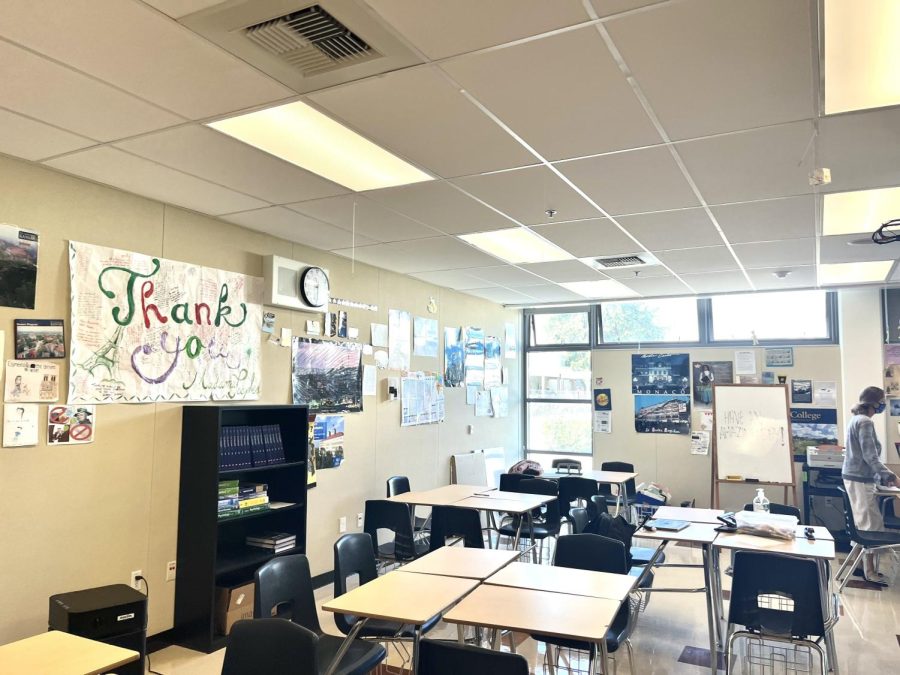Interior Insight
An inside look into Mrs. Peoples’ french class, featuring several posters and a collaborative desk setup.
Michael Morpurgo once said, “It’s the teacher that makes the difference, not the classroom.” However, is this actually true? There are many factors that affect the physical interior of a classroom, including the placement of the desks, temperature, lighting, and even the posters on the wall. All of these factors combine to create a classroom environment that can tell students a lot about the classroom’s expectations and the teacher’s personality.
To begin with, an obvious key factor in a classroom’s interior is the desks and chairs. According to an article by the Education Corner, “The choice in layouts reflect very different teaching philosophies.” Oftentimes, teachers base their classroom in the same way the class is structured. For example, classrooms with desks arranged individually in rows and columns are most likely the lecture-type classes, focusing on independent, student-paced work, and a quiet environment. History and math classes tend to have this type of arrangement, due to the subject’s more personalized learning expectation. In comparison, classrooms with clustered desks lean more towards fostering a collaborative, loud, and engaging environment. According to junior, Vibusha Hiremath, “if teachers have their desks grouped together, I feel more encouraged to work as a team with the people around me, and pay attention.” Usually, engaging classes have their students work together rather than sit silently and listen to instructions. Specifically, these collaborative environments are found in subjects like English and science where students are expected to work as a team. Using these various aspects of a classroom’s seating, teachers are able to structure the desks in order to see the best educational results for their teaching goals. Overall, the placement of the desks in a classroom are extremely important, and closely correlate to the work environment, classroom setting, and expectations.
Another factor in the interior of a classroom, is of course, the lighting. According to a recent study done by Visual Edge, “lighting that is overly bright and fluorescent was shown to contribute to off-task behavior and making hyperactive behavior worse.” This leads to the reason why intensely lit classrooms are often the ones with laid-back teachers and chaotic work environments. JieAn Liao comments, “It always puts me in a better mood when there’s lots of sunshine.” This is due to the fact that soft and natural lighting is often an important factor in maintaining productive and calming environments, in comparison to bright-lighting and energetic classrooms.
Temperature is another essential aspect of the classroom. This year in particular, extreme air-conditioning temperatures have had an effect on the classroom setting and vibe. According to freshman Medha Vinnakota, in her past experiences, chilly classrooms have often been closely associated with “teachers that are more academic-based, less personal, and more distant from the students.” This is actually not a coincidence, studies done by the Teacher Magazine, have shown that warm work environments tend to be correlated to teachers with “warm,” approachable, and friendly personalities. Oftentimes, advanced and academically challenging classrooms will have colder temperatures, coinciding with the workload and higher expectations!
Lastly, and most importantly, a significant component of a classroom interior is the decorations on the walls. This aspect of a classroom, allows students to better understand their teacher’s personality. Senior, Shanti Bannai explained that “teachers who have graduation photos of prior students are normally better teachers, along with note cards from past students.” The inclusion of many posters and physical memories from past years demonstrates that the teacher was able to form close relationships with past students, and be thoughtful about the environment they are providing. These types of teachers are generally more personal with their students, and may be kind-hearted, experienced, and ready to put themselves out there in order to create an educational impact. However, some teachers include little to no decorations on their walls to create a strict, academic atmosphere. These teachers are most likely to include many instructional signs, push students, raise expectations, and increase workload. Due to this, students may need to prepare to work harder in classes with neat and minimalistic decorations.
On the contrary, teachers with an unorganized and messy classroom, can also tell students a lot about the personality of their teacher. Freshmen, Medha Vinnakota explained how some teachers have “a very messy classroom, with random posters on the board and a desk full of random stuff,” and these are often the same teachers that “don’t give a lot of homework” because they are not entirely structured and organized in the learning process. These teachers also provide the impression of being the most easy-going, laid back, and carefree. Whether the walls are overly decorated, minimalistic, or almost entirely blank, they offer an opportunity for students to understand more about their teacher.
Overall, the environment in which students learn in, plays a big part in the educational journey. Whether it is the placement of the desks, extent of lighting, temperature, or the interior decoration, the inside of a classroom can offer plenty of insight on what to expect from the class and teacher. Therefore, the next time you walk into a classroom, consider this interior insight to figure out what you really signed up for.







Little Kids • Oct 12, 2022 at 11:19 pm
I lvoe robnlox this reminda of my favorit roblock game it is abopted me i love that game food job and i love redding this!!